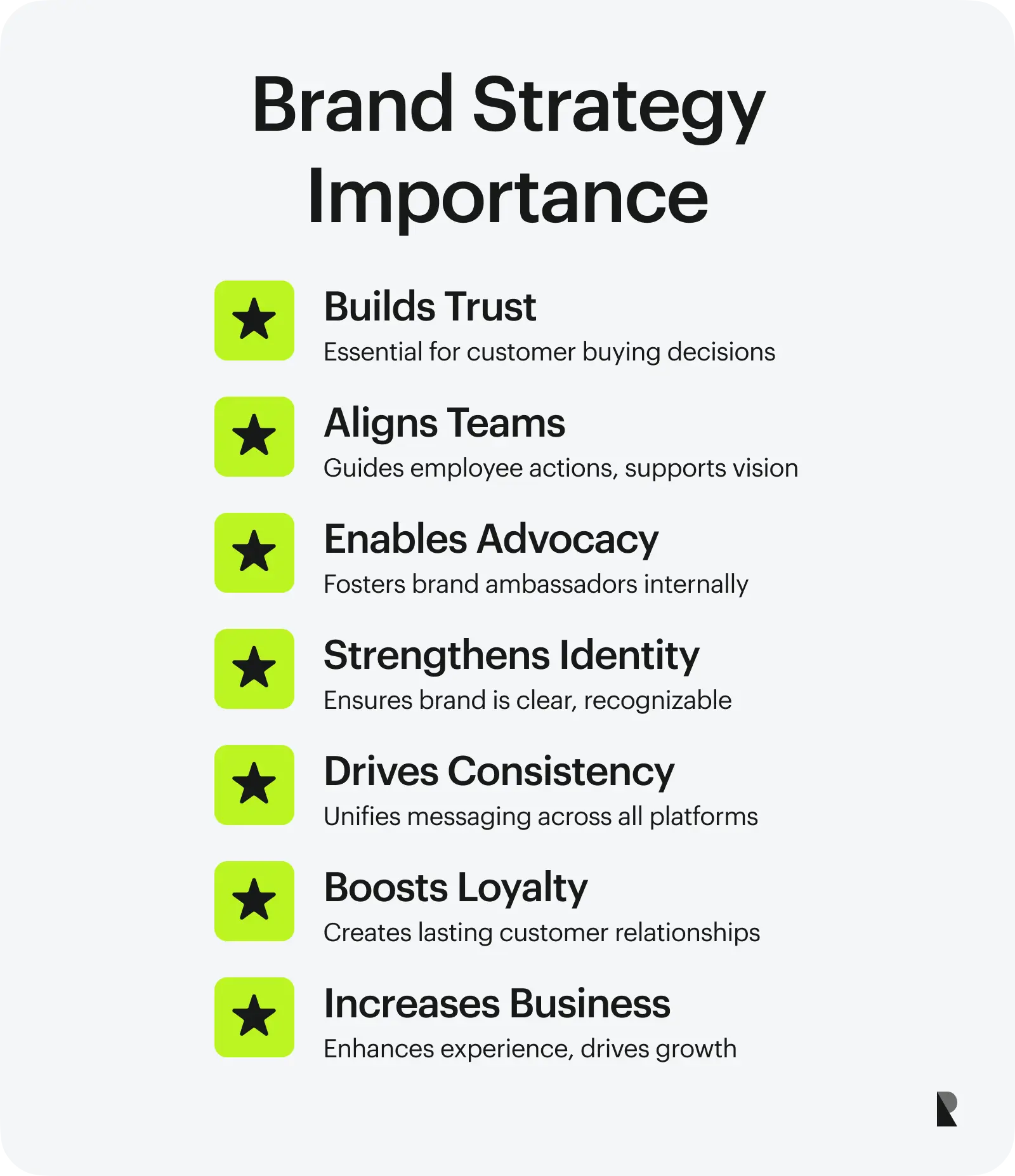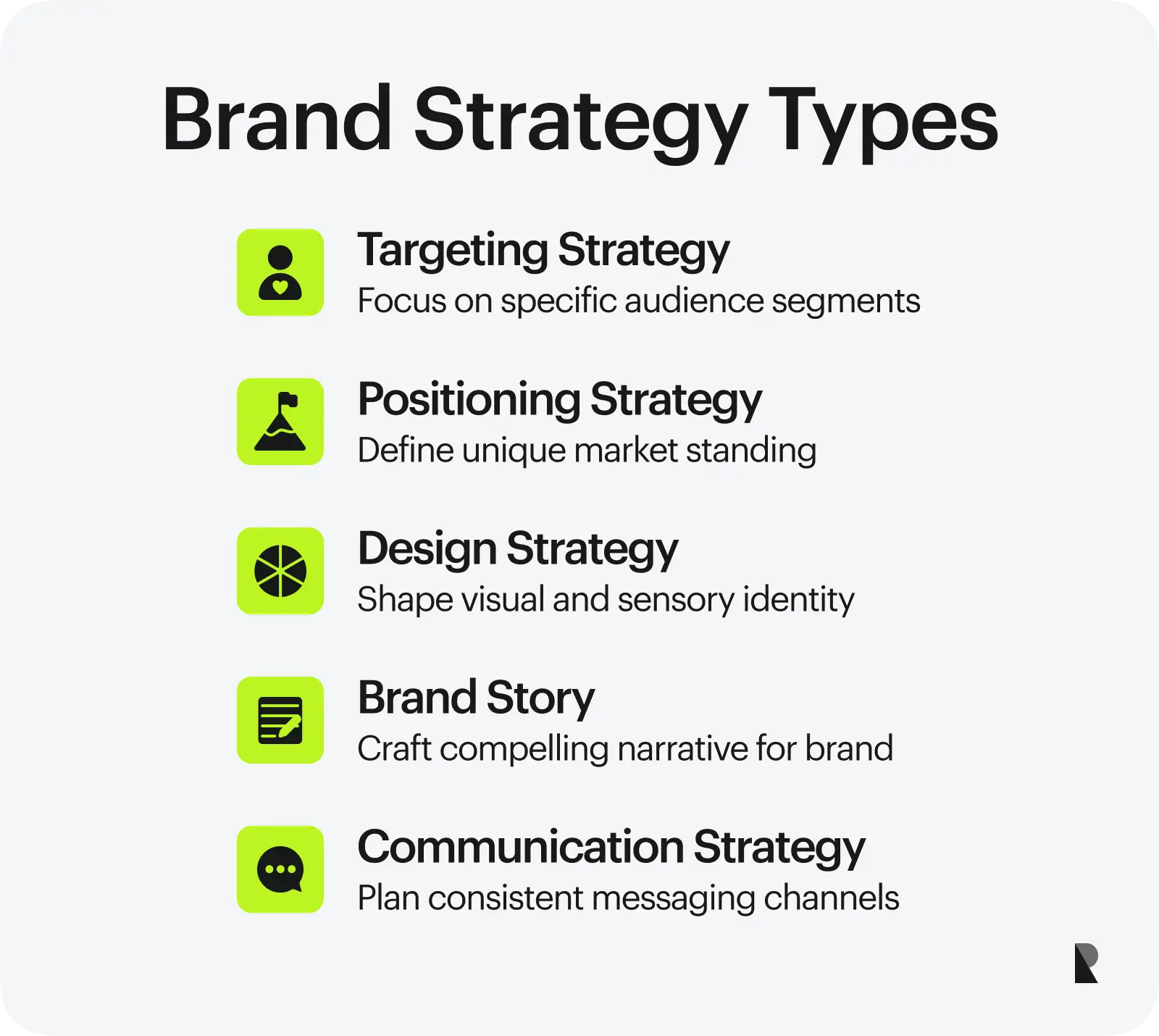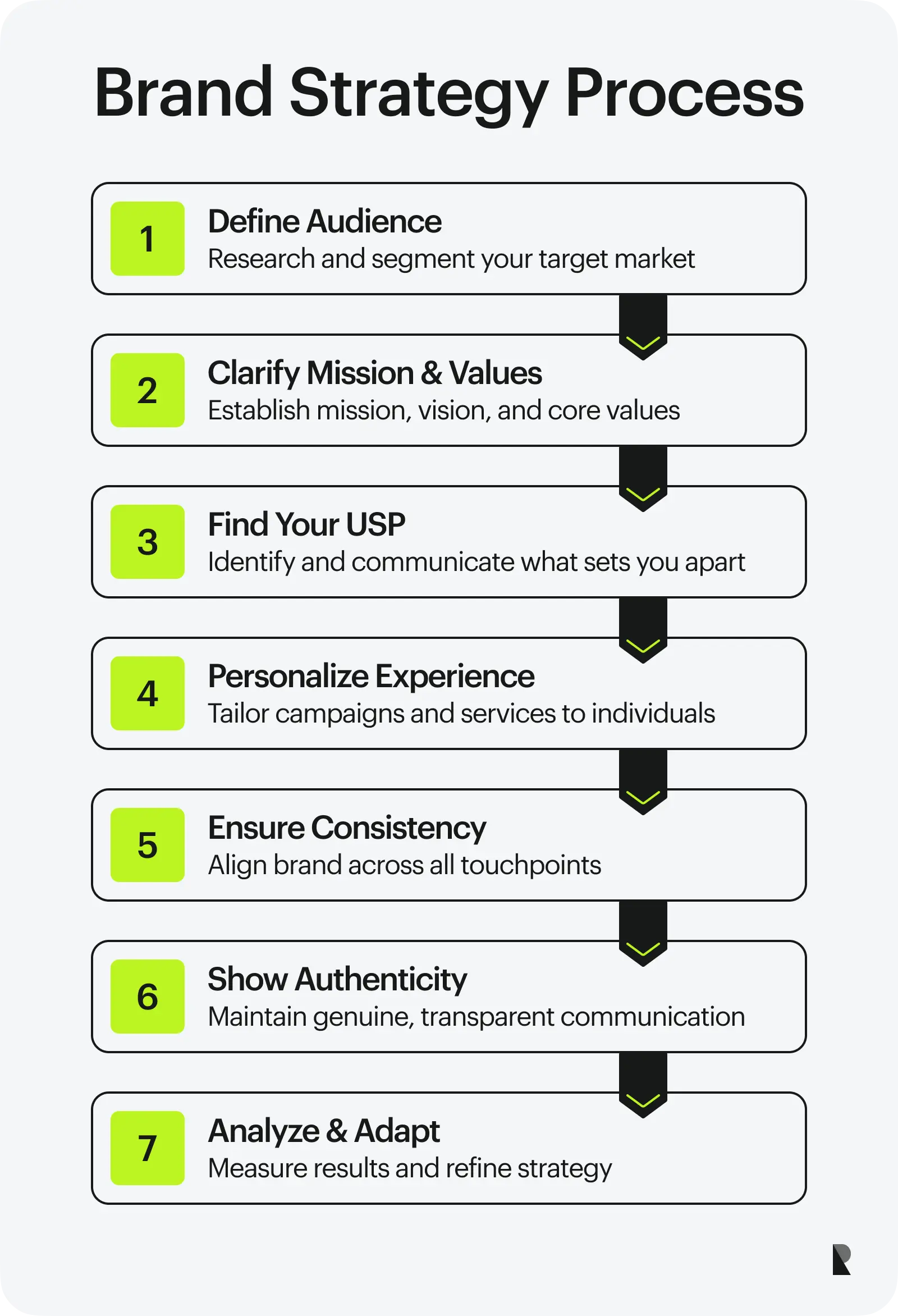
If you’ve been connected to the outside world these last few years, you don’t need us to tell you this, but here goes: Your brand is more important than ever. To run a successful business, you must invest in your brand strategy.
As 70% of customers spend more money on brands they trust while saying bye-bye to those they don’t, it’s evident that your brand strategy is not just here to drive your company direction — but to strengthen your connection with prospects.
Throughout this article, we’ll discuss the concept of brand strategy, why it’s important, and outline different types of strategies that you can use to achieve long-term success. We’ll also have time to jump into the essential elements of a brand strategy, learn the basics of developing one, and finally give you some real-life examples of strategies that have won our hearts.
But let’s start from the beginning.
This modern approach to branding allows you to strengthen your market presence, increase consumer engagement, and improve employee satisfaction by making sure that your branding efforts align with your company’s goals, values, and bottom line.
Why Is Brand Strategy Important?

Once you’ve wrapped your head around that 81% of consumers need to trust a brand before making a buying decision, building a framework to achieve that trust quickly becomes a priority.
With a good brand strategy, you’ll provide employees with a clear roadmap for all their activities, helping them better align actions with your brand’s mission and vision — essentially building a customer-facing brand advocacy program that automatically builds trust over time.
For companies seeking expert guidance in shaping this kind of cohesive direction, partnering with a specialized brand strategy agency can help translate business goals into actionable frameworks that sustain trust and consistency over time.
When your strategy is coupled with a solid, unique selling proposition and consistent brand messaging, you can build a strong, recognizable brand that truly resonates with customers.
Consistent and clear brand messaging across all platforms and touchpoints then gives customers an understanding of the brand’s values, unique offerings, and what it stands for. This helps build a loyal customer base and reinforces the overall customer experience, leading to increased business.
5 Types of Brand Strategies

Just as every brand is unique, so is your business and industry. To effectively implement a brand strategy, you must use different approaches tailored to other aspects of your branding needs to amplify the parts you value most. There are millions of brand strategies out there, but to make things a little easier, we’ve identified five key types to get started.
1. The Targeting Strategy
A brand targeting strategy involves identifying and outlining your target audience to create personalized campaigns. To do this, you need to start by segmenting the audience based on demographics, psychographics, and behavioral traits to tailor branding efforts that resonate deeply with potential customers.
Targeting Strategy Benefits & Uniqueness
| Benefits | Uniqueness |
|---|---|
| Marketing Resources: Focus marketing efforts on the most receptive audience so that you can use your resources effectively. | Audience Segmentation: Splitting the audience into segments allows you to tailor your brand messages better. |
| Customer Engagement: Personalized communication resonates more deeply with people, leading to higher engagement rates. | Data-Driven Insights: Using data analysis to understand audience behaviors and preferences helps cement your marketing efforts. |
| Conversion Rates: Custom campaigns about specific user needs generally result in higher sales and better ROI. | Personalization: Creating personalized content and experiences can turn generic campaigns into real, meaningful connections. |
| Customer Loyalty: Consistently meeting audience needs builds more robust, loyal relationships, fostering repeat business. | Flexibility: Continually working on the strategy based on how your audience responds to it keeps branding efforts effective, up-to-date, and responsive. |
This strategy maximizes marketing effectiveness. Once you’ve identified and understood your target audience, you can create more impactful campaigns that drive sales and foster long-term customer loyalty.
2. The Positioning Strategy
Building a distinct market position is crucial for separating yourself from competitors. A brand positioning strategy focuses on highlighting your special sauce—the unique features and benefits your product or service offers.
Positioning Strategy Benefits & Uniqueness
| Benefits | Uniqueness |
|---|---|
| Consumer Preference: 73% prefer buying from companies aligned with their values. Developing (and communicating) those brand values can set your brand apart. | Value Alignment: Aligning your brand values with those of your target audience helps build deeper connections. |
| Brand Identity: By focusing on unique qualities, you can create a recognizable brand identity that’s focused on your strengths. | Strength Emphasis: Highlighting your brand’s strengths and unique features makes you special. |
| Customer Loyalty: Communicated USPs position your brand as the preferred choice, fostering customer loyalty. | Top-of-Mind Awareness: A healthy brand positioning strategy keeps your brand top-of-mind as customers make purchasing decisions. |
| Competitive Edge: Differentiating your brand helps sustain a competitive edge in a (often) saturated market. | Consistent Messaging: Communicating your brand’s USPs across every platform strengthens your market position. |
A brand positioning strategy is perfect for companies that want to stand out in a competitive market. By defining and communicating your brand’s unique features and values, you’re able to build a stronger brand identity, which, in turn, fosters customer loyalty while maintaining a competitive edge.
3. The Design Strategy
We all love drooling over something visually pleasing. After all, beauty is part of the human experience. So, it’s no surprise that creating a memorable visual identity is also essential for brand recognition. This strategy focuses on design elements such as logos, color schemes, and typography that stand out — and better reflect the brand’s personality.
Design Strategy Benefits & Uniqueness
| Benefits | Uniqueness |
|---|---|
| Visual Appeal: A fantastic design strategy creates a strong, lasting impression. | Logo Design: A memorable logo that captures the essence of the brand. |
| Consistent Identity: Using a uniform design language across all marketing materials builds a consistent brand image. | Color Schemes: Consistent use of brand colors to evoke specific emotions and recognition (be careful here: colors can mean different things in different markets). |
| Trust and Credibility: Consistent and recognizable design elements help build trust and credibility with potential customers. | Typography: Choosing fonts that reflect your brand’s character and enhance readability. |
| Easy Recognition: A visual identity built around the brand helps you stand out and stay recognizable across all touchpoints. | Cohesive Visuals: Ensure all design elements work together to create a unified brand image. |
You also need a decent design strategy to create a memorable and recognizable brand. With a cohesive visual identity, you can enhance your brand appeal, build trust, and ensure consistent brand recognition across all platforms.
4. The Brand Story
Using your company’s history and goals to strengthen brand identity is a winning recipe for building deep connections with your audience. This means translating the brand’s core values, mission, and traditions into stories. Just like oat milk pioneers Oatly, you need to practice what you preach.
Brand Story Benefits & Uniqueness
| Benefits | Uniqueness |
|---|---|
| Emotional Connection: This builds a strong emotional bond with the audience, especially if your company has a rich history or lofty goals. | Core Values: Highlighting the brand’s fundamental beliefs and principles. |
| Customer Loyalty: Engaging stories help foster loyalty and trust. | Mission: Communicating the brand’s purpose and goals. |
| Unique Identity: This helps differentiate the brand from competitors. | Honestly: Share the brand’s history, key milestones, and mistakes and shortcomings. |
| Relatability: This makes the brand more relatable and engaging. | Narrative Style: Crafting an authentic story that resonates with the audience. |
If done right, leaning into your brand story may be the most robust strategy. It’s perfect for building a solid emotional connection with customers. As you share the brand’s journey and values honestly, you will automatically foster loyalty, differentiate yourself from competitors, and create a unique brand identity.
5. The Communication Strategy
Developing a plan for engaging with audiences through multiple channels is critical to maintaining visibility and trust. To do this, you must continue delivering consistent and effective brand messaging across all communication channels.
Communication Strategy Benefits & Uniqueness
| Benefits | Uniqueness |
|---|---|
| Cohesive Brand Image: Focusing on your brand comms allows you to build a unified brand presentation across all platforms. | Social Media: Engaging with the audience through various social media platforms. |
| Trust and Credibility: Consistent messaging builds trust and credibility with the audience. | Email Marketing: Sending personalized and relevant messages to subscribers. |
| Increased Engagement: Effective communication enhances audience engagement. | Content Marketing: Creating valuable content that reflects the brand’s values. |
| Clear Brand Values: This helps the audience understand your brand’s values and offerings. | Public Relations: Managing the brand’s image and relationships with the public. |
Your communication strategy is essential for maintaining visibility and trust. By basing that strategy on your brand values while ensuring consistent and effective messaging across all channels, you can easily build a cohesive brand image and foster trust with prospects.
7 Steps to Develop An Effective Brand Strategy

Building a really good brand strategy might sound easy enough, but believe us, it’s no walk in the park.
Everyone can turn their logo blue and say they’re now protectors of the turquoise pandas — but basing that on core values and actions is much more complicated. Because sooner or later, your audience will realize that there aren’t, in fact, any turquoise pandas.
That said, if you follow these seven steps, you’ll have a solid base on which you can build a truly magical brand strategy:
Step 1. Identify Your Target Audience
Start by conducting audience analysis and segmentation using surveys, focus groups, and market research. It could be a good idea to start talking to users and customers. Through this research, you’ll gain valuable insights into customer demographics, preferences, and behaviors that will serve every part of your brand strategy in the future.
Identifying this target audience is the first step in developing an effective strategy. Once you’ve understood potential customers' characteristics and problems, you can create tailored campaigns that resonate deeply with them.
Step 2. Brand Mission, Vision, and Values
Now, it’s time to clearly define your brand’s mission, vision, and core values. These form the foundation of all branding efforts and guide your brand’s direction and decision-making processes. Clear and well-defined mission, vision, and values provide a solid base for all things branding.
- The mission statement outlines the brand’s purpose and goals.
- The vision statement talks about the long-term objectives.
- The core values reflect the principles and beliefs that guide your brand’s actions and decisions.
This holy triad of brand elements provides a clear direction for your brand and helps ensure that all branding efforts align with its goals and values.
Step 3. Unique Selling Proposition
Find and communicate the unique nuts and bolts of your brand. These are the things that set you apart from competitors. Often, the easiest way is to talk to your employees — or your founders. They’ll have a good place to start. With this knowledge, you’ll be able to attract and retain customers by offering something distinctive and valuable.
The unique selling proposition (USP) makes the brand memorable and appealing. A well-defined USP helps differentiate the brand in the market, create a strong brand identity, and ultimately attract returning customers.
Step 4. Brand Personalization
This is fun: Personalize your brand experiences by leveraging customer data to create unique brand campaigns, products, and services that meet individual preferences and needs.
Brand personalization means using customer data to create custom brand campaigns, products, and services that meet individual customers' specific needs and preferences. Tailoring the brand experience to individual preferences can create a deeper connection with customers and enhance the overall experience.
It also helps build a loyal customer base and foster long-term customer relationships.
Remember to have fun with it. You won’t get it perfectly right from the start; this is all about testing, failing, and trying again.
Step 5. Brand Consistency Across All Touch Points
Consistency is key to building a strong brand. It’s the unsung hero of any successful brand (and the sworn enemy of the less consistent ones).
Always make sure that your brand is presented consistently across all platforms and interactions, from the website to social media to in-person events and talent acquisition. If you’re successful, you’ll build a recognizable brand image that helps build trust and credibility with potential customers and employees, as they can easily identify and connect with your brand.
A good idea is to build brand guidelines and centralize your digital assets so that people can easily find them. A big part of this process is also to educate your employees on the importance of consistency and how to use the brand.
Step 6. Brand Authenticity
You must always maintain genuine and transparent communication with customers. Authenticity builds trust and fosters long-term loyalty. Without it, your brand is an empty shell.
Authenticity is crucial for fostering long-term loyalty with your audience.
Maintaining genuine and transparent communication is also important, as businesses can build a deeper connection, which can also turn into advocacy over time. Authenticity, done right, helps differentiate the brand from competitors and creates a unique brand identity.
Step 7. Analysis and Adaptation
Keep evaluating the brand strategy’s performance using any metrics and feedback you have at hand. Adapt and refine the strategy based on these insights to stay relevant, agile, and effective in the changing market.
Regularly assessing the performance of the brand strategy while simultaneously trying to read the business landscape (trends, moods, problems) helps businesses identify areas for improvement and make necessary adjustments that will also make their brand seem modern and dialed into what’s going on in the world.
Examples of Successful Brand Strategies
The branding world has exploded in recent years. Name a few companies that have captured the extra. Here are three different brands that have found a special formula.
1. Starbucks

Nothing screams, “I’m working on my new movie script,” as sitting down with your Macbook and an overpriced Grande caramel latte with extra everything at Starbucks. Why’s that? Starbucks’ brand strategy focuses on creating a unique, personalized customer experience. Starbucks has built a loyal customer base (scriptwriters) and a strong brand identity by emphasizing high-quality products, a comfortable store environment, and a strong brand community.
2. Airbnb

Airbnb’s brand strategy is centered around the concept of “belonging anywhere.” This mantra helps promote a sense of community and authentic travel experiences. Airbnb has successfully differentiated itself from traditional hospitality services and connected deeply with its target audience. The company’s emphasis on trust and safety also helps build a strong brand image and foster loyalty among its users.
3. Amazon

Amazon’s brand strategy is more or less centered on customer obsession, convenience, and innovation. As they’re able to consistently deliver on its promise of fast, reliable service and continually expand its product offerings, Amazon has become a dominant force in the e-commerce industry. The company’s focus on customer satisfaction and its commitment to innovation help build a strong brand image and foster customer loyalty.
Conclusion
So, what have we learned here? Well. A brand strategy is paramount for businesses that establish a strong market presence and foster long-term success.
Understanding and implementing brand strategies, defining essential elements, and following best practices can help businesses create compelling brand identities that resonate with their target audience.
At the end of the day, your brand strategy is the foundation upon which your brand’s success is built—and you have the opportunity to make it count.
If you want to get a head start, our brand strategy firm is here to help you realize your brand's wildest dreams through tailored strategies that ensure your brand stands out and thrives in the competitive market. Don’t hesitate to contact us at any time.
Jun 14, 2024
